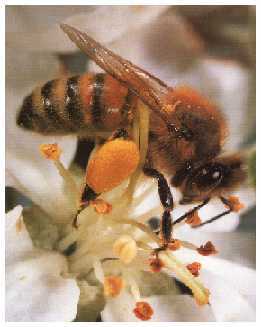Home Classes Live Stream Products Educational Videos Pollen Links Disease & Pests
A-Bee Honey
|
To order Bees click here ________________________________________________
Educational Videos
Welcome to the University of Guelph Honey Bee Research Centre's online beekeeping video series! The goal of the University of Guelph was to provide new and advanced beekeepers with demonstrations by their staff on a variety of topics ranging from how to open a hive to queen rearing. We'd like to thank the University of Guelph Alumni Association and all of the generous donors for their successful crowdfunding campaign to produce this video series.
Educational Videos Main Page Supering Hives
Swarm
Control
Splitting
Hives
Moving Hives
Harvesting
Honey
Feeding Bees and Overwintering
A Year in the Life of an Apiary Part 1
To order Beesclick here
A Year in the Life of an Apiary Part 2
To order Bees click here
A Year in the Life of an Apiary Part 3
Bee Biology and Equipment Part 1
To order package Bees or Nucs click here
See this video on Oxalic Acid treatment for varroa
A GUIDE TO EFFECTIVE VARROA SAMPLING & CONTROL
|
Educational Videos
University of Guelph Beekeeping Research Center
The following videos are compiled by various sources and are excellent material for training beekeepers. Please understand that the information presented may not reflect the same attitude and beliefs of A-Bee Honey or Costanza Orchards in the various management practices that are exhibited in these video presentations. Unless stated the following videos were posted on YouTube. The series titled "University of Guelph" are presented on YouTube with permission of the University of Guelph Center for Continuing Education. Because of the value of these videos to our industry we are listing them here. UoG's Honey Bee Research CentreGetting Started With Bees Hive Location and Setup Protective Clothing Smoke Use Stinging Hive Equipment Comb Building Working With Bees Opening Hives Colony Inspection Introducing a Nucleus Hive Colony Management Supering Hives Swarm Control Splitting Hives Moving Hives Feeding Bees and Overwintering Dealing with Deadouts (Part 1) Dealing with Deadouts (Part 2) Managing Towards Gentle Behavior Single Brood Chamber Working with Queens Finding Queens Requeening Marking and Clipping Queens Caring for Caged Queens Why Buy Queens Queen Rearing Grafting Queen Cells Cell Building Part 1 Ontario Introductory Queen Rearing Manual Cell Building Part 2 Handling Queen Cells Making Mini Nucs 4 Way Mating Nucs Double Nucleus Colonies Making Double Nucleus Colonies Part 1 Making Double Nucleus Colonies Part 2 Fixing Problem Double Nucleus Colonies Transfering Double Nucleus Colonies Abnormal Colony Conditions Abnormal Conditions Part 1 - Failed Queens and Chalk Brood Abnormal Conditions Part 2 - Wax Moth, Monitoring Mites Abnormal Conditions Part 3 - Laying Workers, Sacbrood Laying Worker Honey Harvesting Tipping Hives Harvesting Honey Honey Extraction Honey Moisture Pest Management Fumigating for Nosema Varroa Alcohol Wash Varroa Population Dynamics Varroa Sticky Boards Low Varroa Growth Low Varroa Growth Part 1 Low Varroa Growth Part 2 Low Varroa Growth Part 3 Working with the ORHBS Program Miscellaneous Our Beekeeping Equipment Bear Fence Beekeepers Knot Buckfast Queen Mating Thorah Island Indoor Overwintering Bee Beards
Click here to see Products To order Bees click here |
To order Bees click here
Educational Videos
Lighting A Smoker the Easy Way
A Year in the Life of an Apiary
Bee Biology & Equipment
Where we get the Lumber for the Products we make Feeding and Adding Supers for Expansion of the Brood Nest (Chamber) Drone Comb Removal to Reduce Varroa Mites Inspecting a hive that was formerly a Tear Out
Educational Papers Supplemental Feeding of Honey Bee Colonies Educational Videos
We purchase rough sawn pine products from the Kuykendall's in Tres Piedras, NM (30 miles west of Taos) to mill into our bee products. Here we are loading on March 3rd 12" pine lumber. We will place it in a solar kiln in Edgewood and add fans and heaters to speed up the drying process before we can begin to mill this lumber into supers, frames, tops and bottoms and other hive components. Lanny and his family can be reached at 9 Rodeo Road, Tres Piedras NM 575-751-0901 Educational Videos < Feeding and Adding Supers for Expansion of the Brood Nest (Chamber) What is one way to effectively expand the brood nest? This video shows how to add frames in a manner that will encourage the hive to quickly expand the brood nest. We are also encouraging the hive to increase in numbers in advance of a nectar flow. Educational Videos
While working hives at one of our apiaries we noticed a hive where the bees began to cluster on the front of the hive. What was the reason? Preparation for swarming, over crowding or over heating? We take a look into this hive and correct the problems.
Single Hive Management Explained
To order Bees click here |
Updated Audio Version
